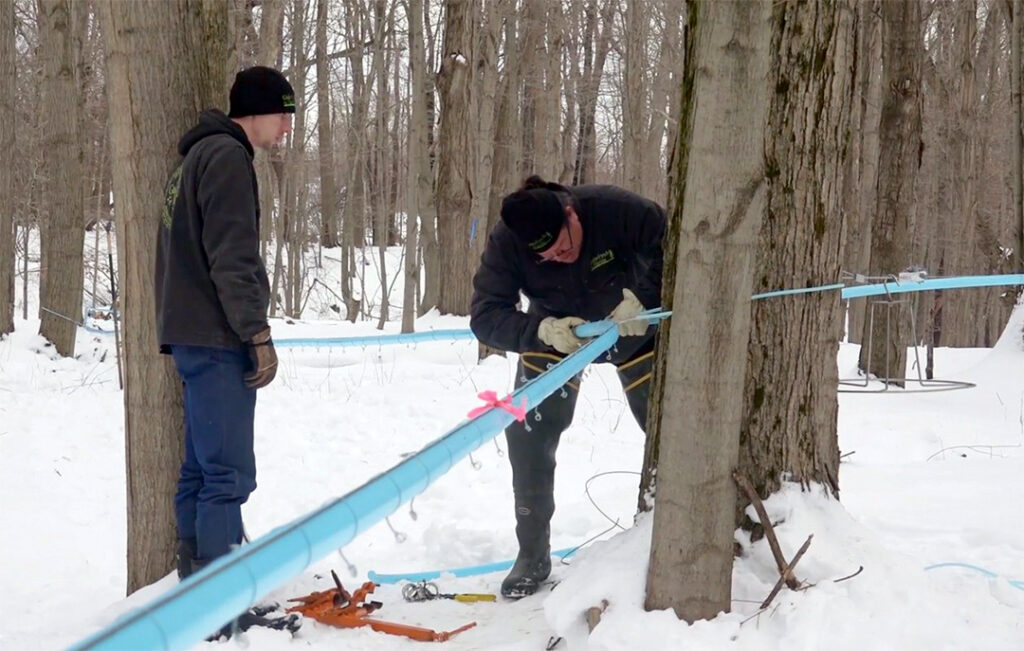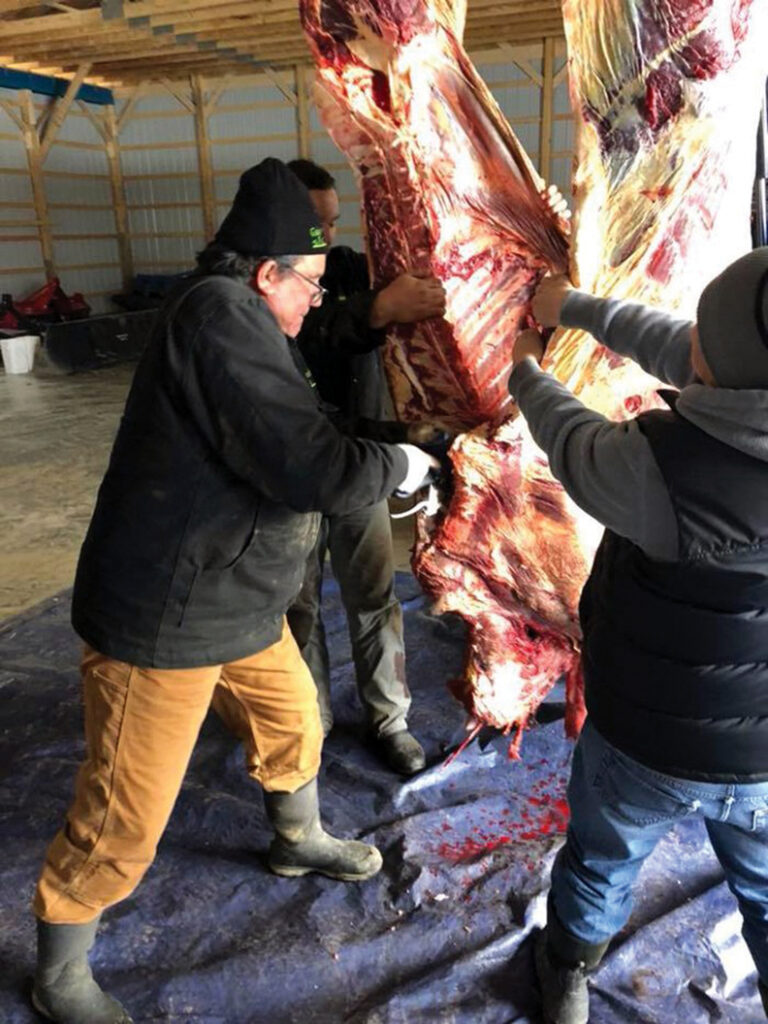By Gabriel Pietrorazio | January 14, 2021 | Reprinted from civileats.com | Photo credit: Seneca Media & Communications
For Michael Snyder, it was canceling the Gakwi:yo:h Farm’s annual Maple Weekend that drove home how serious the pandemic would hit the Seneca Nation.
Snyder, the director of the agriculture department for the Seneca Nation, has overseen a number of efforts to rebuild food sovereignty among the Seneca, including the development of Gakwi:yo:h Farms, the growth of a bison herd on the Nation’s reservation, and the ongoing construction of a new cannery facility.
And Maple Weekend – scheduled for late March 2020 – would have been the perfect showcase. Instead, everything was going to have to be put on hold.
“A week before we were going to do Maple Weekend. I’m pulling all our maple products and our bison meat, everything that I have and setting it aside until the pandemic passed,” Snyder said.
Snyder’s work grew out of the Food is Our Medicine initiative, launched in 2013 by the Seneca Diabetes Foundation and funded to encourage healthy eating through gardening, canning, and education about culturally significant plants. Because no farm existed on Seneca land, the initiative helped fund the establishment of Gakwi:yo:h Farms, whose name means “good food” in Seneca, and whose mission is to increase the Nation’s food security and food sovereignty by promoting traditional agricultural practices and engaging with the community through food.

The founding of their farm started from the ground up, an entirely Indigenous enterprise focused from the start on everything from creating to branding, marketing, and packaging its own goods. Training new growers is also an important goal for Gakwi:yo:h Farms.
“We want to provide a resource to grow – and we’re not only growing produce, we’re growing farmers,” Snyder said.
In 2018, he and his team began planting traditional white corn, tomatoes, potatoes, and other crops across the 54-acre central farm hub in Cattaraugus. It was the start of their efforts to expand their acreage, increase the number and types of foods they produce, and find new ways to get that food to people who need it.
When the pandemic hit, the Nation shut down its casinos, closed their communities to outside visitors, and issued a stay-at-home order on their reservation in New York State. Nevertheless, it continued to prioritize food production – and despite the public health crisis – it has managed to increase the size and reach of Gakwi:yo:h Farms.
With the help of the Nation’s Council, the farm has gained access to unused land bot on and off the reservation – and has expanded the cultivation of Indigenous crops and the raising of culturally significant animals.
On the 410 new acres that have come into the Nation’s possession since March, the Seneca are now raising Red Angus cattle for meat, establishing a bison herd to be hunted seasonally, and tapping more trees for maple syrup. They are also in the process of opening a new cannery that will enable those who reside on the reservation to process and store produce while also finding innovative ways to distribute food to people in need.
Together, these efforts are reducing the Nation’s reliance upon non-Indigenous food systems while also enhancing its own self-determination after what Snyder describes as a long period of disconnect with their land. Now, he adds, the project is shining a new light on the potential of agriculture as a source of self-sufficiency.
“I’m an activist first and a farmer second, but I think a lot of it goes hand in hand. Food sovereignty is still sovereignty,” Snyder said.
Despite the forward progress, however, the Nation still faces challenges in gaining full food sovereignty, including a lack of processing capabilities and funding shortages.
The Lease of a Dairy Farm – and a New Partnership through Maple Syrup
Over the last two years, the new farm has grown parcel by parcel across the split Cattaraugus and Allegany territories that comprise the entire 21,618-acre reservation.
Just before the pandemic started, the Seneca Nation signed a 10-year lease for 25 acres from a multigenerational dairy farm located just 15-minutes away from the Cattaraugus territory in the town of Forestville. Run by the Gage Family since 1906, the farm was in the midst of shuttering its business. With the additional land, the Seneca began growing their maple syrup operation.
Maple products have deep meaning for the Seneca, one of the original Five Nations of the Haudenosaunee Confederacy.
Their creation story includes the invention of maple syrup, a sign that spring has arrived and a time to celebrate.
Before colonial days, the Seneca traded farm goods with other Nations, and maple syrup was a rare and valuable commodity. In recent years, the homemade syrup has been sold out due to high demand at the farm store; they otherwise produce only enough to sell in casino gift shops.
The lease of land between the Senecas and the Gages, which involved only the exchange of two gallons of maple syrup, came about shortly after Allen Gage, 26, joined the staff of Gakwi:yo:h Farms as a livestock handler, becoming the only non-Indigenous farmworker among Snyder’s staff of 15.
Gage was motivated to give them access to his family’s property out of an interest in “helping people grow, because times are kind of rough right now.”
Even though the COVID-19 infection rate is low for the Seneca Nation, the pandemic has reshaped farm life. It has affected their planting and harvesting schedules while also requiring Snyder to close Gakwi:yo:h Farms to the public.

Still, some residents on the reservation opposed the deal, asking why the Seneca Nation was willing to spend their resources investing in non-Indigenous lands. But Snyder said the deal is mutually beneficial. “We’ve been neighbors with all these different communities for a long time, but we’ve never really worked together,” Snyder said.
He wants to build more connections with the local community and show that “we can work peacefully.”
So far, Gage estimates, the Seneca have spent thousands of dollars on improvements to the land and its infrastructure, including new sap-collecting lines to replace a 10-to-15-year old system. Additionally, they cleared a 100-yard stretch of overgrown pasture and laid millings to construct a culvert in the driveway, allowing them to easily haul loads of syrup off-site.
Beyond the Gage property, the Nation also granted the farm access to 50 acres near the Seneca Niagara Resort & Casino to tap even more maple trees.

Gage also hopes the expansion of the Nation’s syrup-making capacities will enable the farm to send bottles of syrup to the casinos and allow an additional portion for trading with other Nations in the future.
Raising Livestock Underscores the Need for Processing Facilities
The Gage family’s farm property is just one of six recent land parcel acquisitions that have expanded Gakwi:yo:h Farms amid the pandemic, amounting to more than 400 acres of new land.
The new land acquisitions have enabled the farm to increase their various livestock operations.
In June, Snyder started grazing 25 new Red Angus beef cows and he has also worked to establish a bison herd, purchasing the animals one by one from local vendors. The Nation started with 14 bison in 2018 and now has 51. Another recently secured land acquisition, Ohi:yo’ at the Sunfish flats, a sprawling 300-acre plot of undeveloped land, will allow the wild animals to roam freely – and eventually to be hunted routinely, but Snyder said he needs to continue to “build the herd up” before they could hunt one each in both territories, every season.
Despite all these upgrades, the Nation still faces a lack of processing facilities for both meat and produce.
Early in 2020, the Nation’s Western Door Steakhouses sought to purchase bison loins from Gakwi:yo:h Farms to put on their menu, but pandemic-related closures left that meat unclaimed. Additional bison died during the move to Sunfish. And because the Seneca had no USDA-certified processing facility, they couldn’t sell any of that meat.
Although Gakwi:yo:h Farms are regular customers with four or five local, non-Native butcher shops, the pandemic-fueled slaughter house backlog hit them there as well. When he called the shops in September, the soonest Snyder could secure an appointment was in March.
“There’s a real need for more of these local processing plants for meat as well as other kinds of foods,” said Elizabeth Hoover, a Mohawk who is of Mi’kmaq descent, an author, and an associate professor at U.C. Berkeley. For this reason, she added, there has been a growing call across Indian Country for more Indigenous-owned meat processing facilities.
With continued concerns over COVID outbreaks inside cramped meat packaging facilities, Indigenous-owned facilities are “able to keep it right within the community rather than having to ship it out,” Hoover added.
The Cherokee and Muscogee Creek obtained access to CARES Act funding to build their own meat processing facilities amid the pandemic, but the Seneca continue to process meat for their own consumption on the reservation in the meantime until March, when they can work with a USDA-certified facility to process meats for commercial sale.
The lack of processing capacity is not just for livestock. In the case of white corn, which is central to Seneca culture, “you can’t just eat it off the cob,” Hoover said.
The Nation currently sends its white corn for preservation through a partnership with the Friends of Ganondagan and Iroquois White Corn Project in Victor, New York. Now they are in the process of developing a commercial cannery on-site at the main farm hub.
Because casinos have shut down and gambling revenues have dried up, the Seneca—like many other Nations—are struggling to find the capital to fund their farms and other food initiatives.
“[Casinos] have provided the funding to get some of these farms and food projects going,” Hoover said, “but when they don’t do well, how can you continue to invest in these farms, [which] provide food directly to the community?”
Hoover believes the pandemic should be a wake-up call for Indigenous communities like the Seneca. “You can’t eat money,” she added.
Despite these challenges, the farm has found innovative ways to make the most out of the difficult situation—in many cases, by simply offering fresh, free food to those who reside on the reservation.
Gakwi:yo:h Farms has hosted several food distribution events, where they gave away the 400 pounds of bison mentioned earlier, as well as over 500 pounds of pork, 70 pounds of venison, 25 walleyes, and 900 pounds of potatoes, according to Snyder.
The Seneca Nation also engineered ways to take their products on the road through both territories this summer. LeRoy Henhawk, 43, a Seneca from the Turtle Clan, helped organize the “Renegade Mobile Market” for the farm every Tuesday and Thursday starting in July.
They lost income from missing their regular farmers’ markets, and yet “the profits were still a lot better this year,” Henhawk said. “There were good days, bad days, but definitely there’s a lot more customers than we had in the past year.”
Looking ahead, he’s hoping to purchase a new vehicle—“almost like a grocery store on wheels,” he added.
In the midst of a global pandemic, Henhawk says their farm crew has still done a great job this year. Snyder isn’t the only one from the Seneca Nation noting that the community takes great pride in the fact that the farm is feeding the Nation during difficult times, which didn’t even exist more than two years ago.
“I don’t want people to think we’re vulnerable,” Snyder said. “We are relying on the bigger food system, no doubt, but I think it eases their minds to know that [if] push came to shove, we have all this stuff. We not only survived, but we thrived.”




